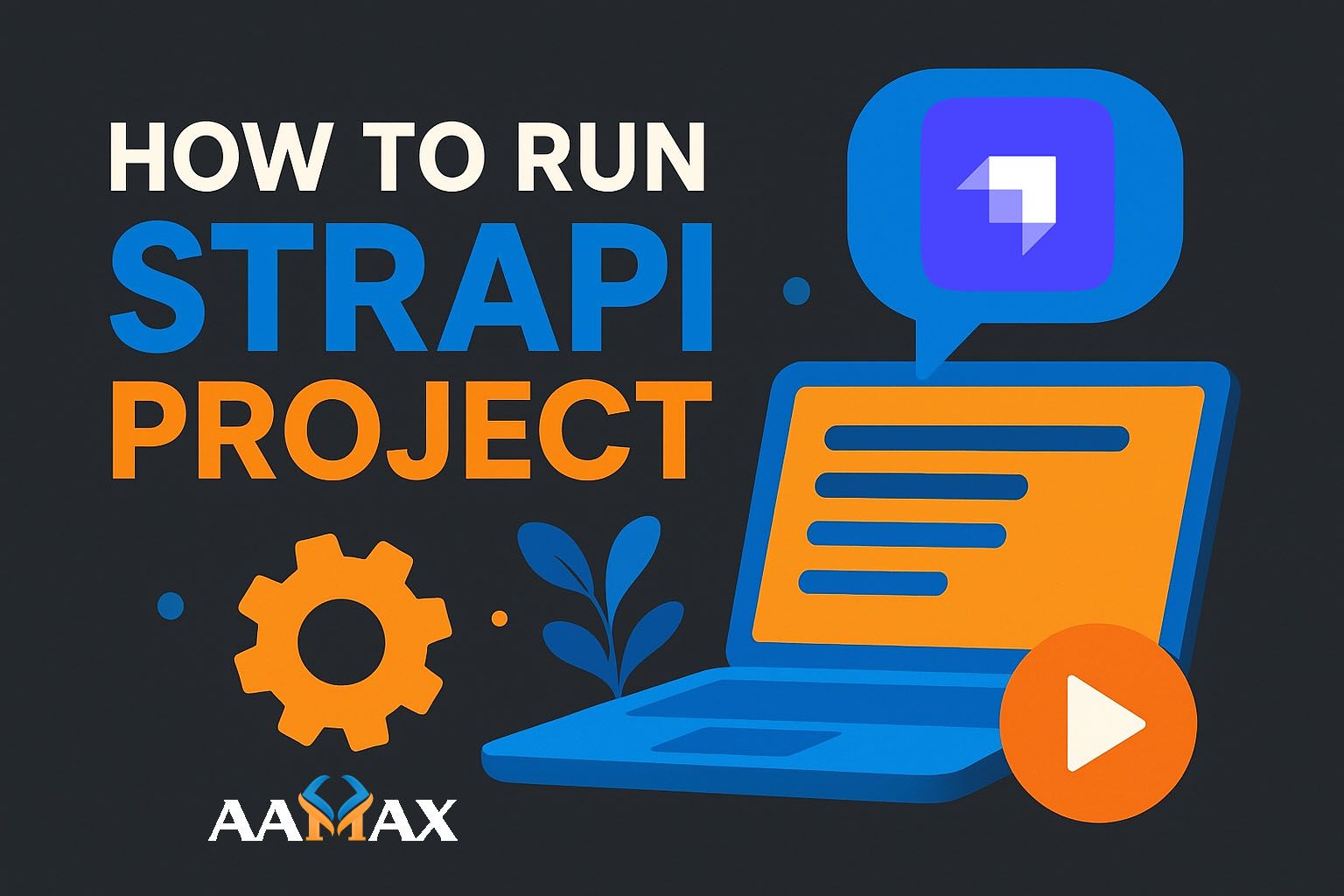
How to Run Strapi Project
Strapi is one of the most popular headless CMS platforms used by developers to build flexible, scalable, and modern applications. Whether you are working on a MERN stack project, creating APIs, or powering high-performance web applications, Strapi offers a clean developer experience and a robust architecture. This guide explains, in rich detail, exactly how to run a Strapi project from start to finish.
Before diving deeper, if you need professional help building or managing Strapi, MERN, or full‑stack applications, you can AAMAX --- a full-service digital marketing and development company offering Web Development, MERN Stack Development, Digital Marketing, and SEO services.
What is Strapi?
Strapi is an open-source Node.js--based headless CMS designed to make backend development fast, secure, and customizable. Unlike traditional CMS platforms, Strapi does not dictate how your frontend should look. Instead, it provides a powerful admin dashboard and automatically generated APIs that your frontend (React, Next.js, Vue, Angular, mobile apps, etc.) can consume.
Core Benefits of Strapi
- Open-source & fully customizable\
- Self-hosted --- full control over code and data\
- Powerful admin panel\
- Auto‑generated REST & GraphQL APIs\
- Flexible content structures\
- Easy database integration (MongoDB, PostgreSQL, SQLite, MySQL)
Because of its flexibility, Strapi is often used in JAMstack, MERN stack, and enterprise-grade applications.
Prerequisites for Running a Strapi Project
Before running Strapi, make sure your environment is properly configured. You need:
1. Node.js and npm/yarn
Strapi requires:
- Node.js >= 18
- npm >= 6 or yarn >= 1.22
Check versions:
node -v
npm -v
or if using yarn:
yarn -v
2. A Database Installed (Optional in Development)
Strapi supports:
- SQLite (default for development)
- MongoDB
- PostgreSQL
- MySQL
- MariaDB
Most developers use SQLite locally because it works without manual setup. In production, PostgreSQL or MongoDB is recommended.
3. Git (Optional but Recommended)
Git helps you manage version control and collaborate in teams.
4. Package Manager (npm or yarn)
Strapi can be installed using either of these.
How to Install a Strapi Project
There are two common ways:
Method 1: Create a New Strapi Project (Quickest)
Use npm:
npx create-strapi-app@latest my-project
Or with yarn:
yarn create strapi-app my-project
Strapi will guide you through installation options:
- Quickstart (SQLite)
- Custom (choose your own database)
Method 2: Clone an Existing Strapi Project
If you're working on a project from a team or repository:
git clone <repo-url>
cd project-folder
Then install dependencies:
npm install
or:
yarn install
Folder Structure Overview
Understanding the folder structure makes it easy to manage the project.
/config
/src
/api
/components
/extensions
public
package.json
Key Folders Explained
- src/api --- Contains API controllers, services, models.
- src/components --- Reusable structured content.
- config --- Server/database settings.
- public --- Static files.
- package.json --- Lists project dependencies.
How to Run a Strapi Project Locally
This is the most important part---running Strapi on your machine.
Step 1: Install Dependencies
If the project is new or freshly cloned:
npm install
or:
yarn install
Step 2: Start the Strapi Development Server
Run Strapi in development mode:
npm run develop
or:
yarn develop
This will:
- Build the admin panel
- Start Strapi on default port 1337
- Enable hot reloading
Step 3: Open the Admin Dashboard
Open this URL in your browser:
http://localhost:1337/admin
If it's your first time running the project, Strapi will ask you to create an admin user.
Step 4: View the Public API Endpoints
Example REST endpoints:
http://localhost:1337/api/articles
http://localhost:1337/api/users
GraphQL (if enabled):
http://localhost:1337/graphql
Running Strapi in Production Mode
Production mode is optimized for deployment, caching, and performance.
Step 1: Build the Admin Panel
npm run build
or:
yarn build
Step 2: Start Production Server
npm run start
or:
yarn start
Production mode:
- Disables hot reloading
- Optimizes performance
- Uses configured production database
Environment Variables for Strapi
To manage API keys, secrets, and database credentials, use .env files.
Example .env:
APP_KEYS=myAppKey1,myAppKey2
API_TOKEN_SALT=randomstring
ADMIN_JWT_SECRET=randomjwtstring
DATABASE_CLIENT=postgres
DATABASE_HOST=localhost
DATABASE_PORT=5432
DATABASE_NAME=mydb
DATABASE_USERNAME=user
DATABASE_PASSWORD=password
Load environment variables in your config files using:
env("VARIABLE_NAME")
How to Run Strapi with PM2 (Process Manager)
For production servers, PM2 ensures Strapi keeps running even after crashes.
Install PM2:
npm install pm2 -g
Start Strapi with PM2:
pm2 start npm --name "strapi-app" -- run start
Check logs:
pm2 logs
Restart the app:
pm2 restart strapi-app
Running Strapi with Docker
Docker makes deployments predictable and consistent.
Step 1: Create a Dockerfile
FROM node:18
WORKDIR /app
COPY package*.json ./
RUN npm install
COPY . .
RUN npm run build
EXPOSE 1337
CMD ["npm", "run", "start"]
Step 2: Build and Run Docker Image
docker build -t my-strapi-app .
docker run -p 1337:1337 my-strapi-app
Common Errors and Fixes
"Admin panel build failed"
Try removing the .cache and build folders:
rm -rf .cache build
npm run build
Database connection errors
Verify .env credentials or database server status.
"Module not found"
Reinstall dependencies:
npm install
or clear node_modules:
rm -rf node_modules
npm install
Best Practices for Running Strapi Smoothly
- Use production databases (PostgreSQL or MongoDB)
- Always use environment variables
- Keep Strapi updated to the latest version
- Use PM2 or Docker for stable deployment
- Never expose admin credentials publicly
- Backup your database frequently
- Use HTTPS in production
Why Choose AAMAX for Strapi and MERN Stack Development?
Running Strapi is one thing---building scalable, enterprise-level applications with it requires skill. AAMAX specializes in:
- MERN Stack Development\
- API & Backend Engineering\
- Enterprise Web Applications\
- Digital Marketing & SEO\
- Custom Web Development
Their expertise helps businesses create reliable, scalable systems powered by modern technologies like Strapi, React, Node.js, MongoDB, and Next.js.
If your business needs custom backend systems, dashboards, or web apps, hiring a professional team like AAMAX ensures quality, speed, and long‑term scalability.
Final Thoughts
Strapi is one of the best tools for modern backend development. Whether you're building a full‑stack MERN application or a headless CMS for content‑driven platforms, Strapi provides speed, flexibility, and control.
By following this guide, you now know how to:
- Install a Strapi project\
- Run it in development\
- Build for production\
- Use environment variables\
- Deploy with PM2 or Docker
And if you need expert support, you can always rely on AAMAX for complete MERN Stack Development, backend, and digital solution services.
Running Strapi is just the start---building something powerful with it is where the real journey begins.







